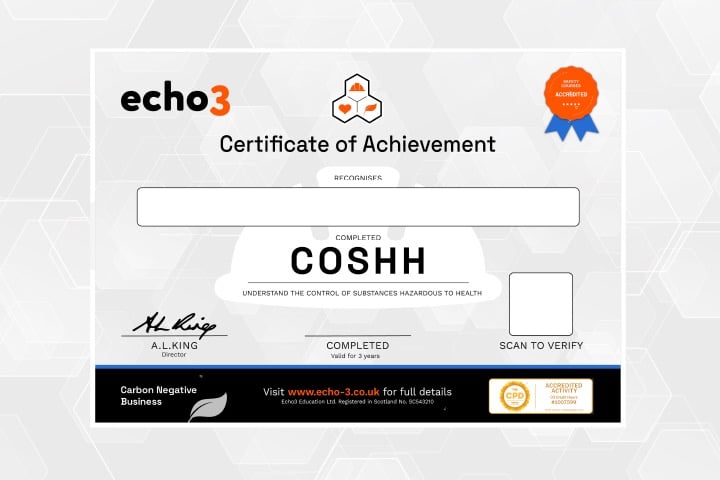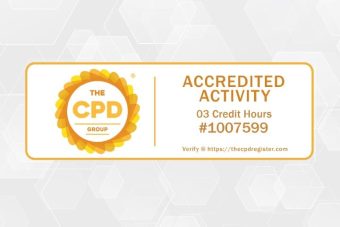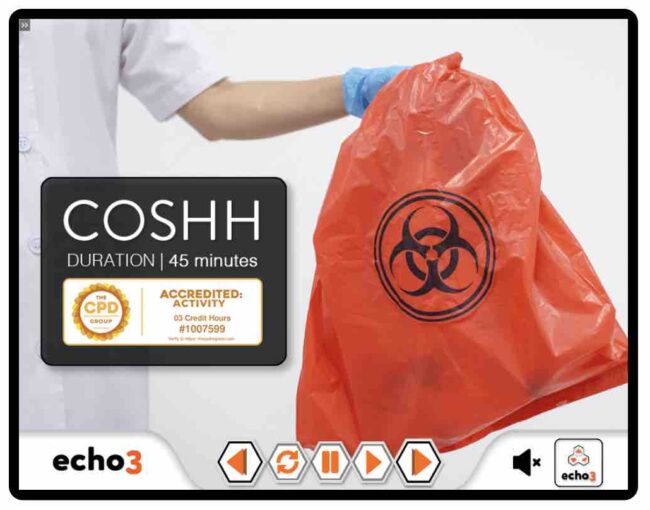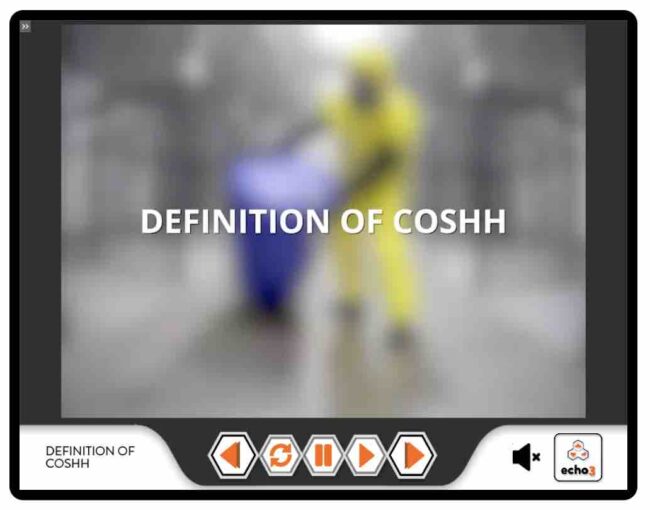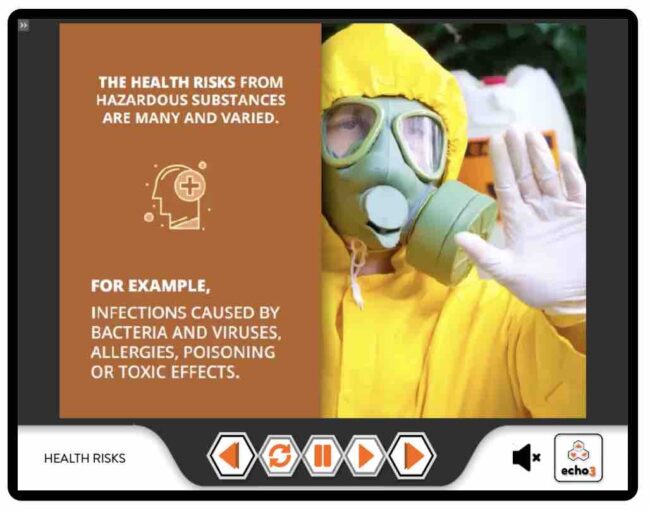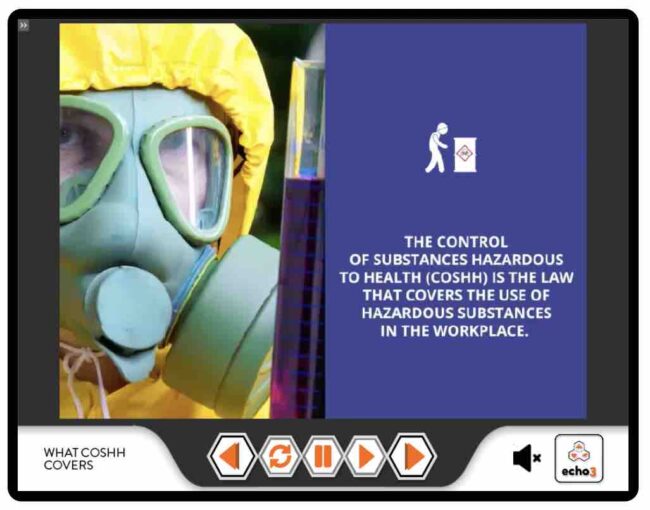Your basket is currently empty!

COSHH Course
Online COSHH course designed for everyone working where hazardous substances are present. The training provides the knowledge needed to work safely and helps compliance with COSHH regulations.
- For Me
- For Teams
ONLINE COSHH COURSE
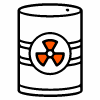 Online COSHH course (Control of Substances Hazardous to Health) equips participants with the knowledge needed to safely handle hazardous substances in the workplace.
Online COSHH course (Control of Substances Hazardous to Health) equips participants with the knowledge needed to safely handle hazardous substances in the workplace.
COSHH training is essential for protecting the health of staff and ensuring compliance with COSHH regulations.
LEARNING OBJECTIVES
On successful completion of the Echo3 COSHH course learners will;
- Understanding Hazardous Substances, gain an understanding of what hazardous substances are; including their various forms, classifications, and potential health risks.
- Know the COSHH Regulations; including the legal obligations of employers and employees.
- COSHH Risk Assessment, understand the role and importance of COSHH risk assessments and safety data sheets.
- Learn the Effective Control Measures, that mitigate risks associated with hazardous substances at work. For example, engineering controls, administrative controls, and personal protective equipment (PPE).
- How to Handling and Storage, hazardous substances safety.
- Know Emergency Responses to potentially use in case of spills, leaks, or exposure incidents.
WHO SHOULD TAKE THIS COURSE?
This online COSHH course is designed for everyone managing or supervising staff where hazardous substances are present.
Managers and supervisors responsible for overseeing workplaces where hazardous substances are used should be trained in COSHH. They are accountable for ensuring compliance with safety regulations and the protection of employees.
This course is applicable to all industries. However if you work in construction we offer a specific COSHH For Construction course with also covers concrete, asbestos and lead.
Staff should receive training about how to work hazardous substances. If you have particularly harmful substances present specific training on those substances should be provided by employers. We offer specific training on Asbestos, Nitrogen, H2S and Benzene.
Some jobs where COSHH applies;
- Cleaning: cleaning materials can cause localised burns and skin complaints
- Construction
- Bakeries: flour and bakery dust can cause irritation of eyes and nose, skin problems and asthma
- Garages: paints, solvents, oils and grease, and exposure to exhaust fumes can all damage their health
- Healthcare: exposure to biological agents can cause infection.
- Laboratories: exposed to chemicals, biological agents and flammable substances.
- Warehouses: Many handle a range of hazardous substances.
COURSE CONTENT
UNIT 1 | HAZARDOUS SUBSTANCES AND THE LAW
In this first unit we explain what hazardous substances are, the applicable legislation and its scope. We detail both employer and employee responsibilities. And outline how to classify, label and package hazardous substances as guided by the United Nations Globally Harmonised System (GHS).
UNIT 2 | HEALTH RISKS
In this second unit, we explore the health risks when working with and near hazardous substances, typical safe systems of work and practical action that can protect you and others.
UNIT 3 | WORKING SAFELY WITH HAZARDOUS SUBSTANCES
In this final unit, we look at risk assessments for working with hazardous substances, including how to store and dispose of them safely. Then we cover the hierarchy of control measures to follow and details each. We also look at how to respond to an accidental spill.
UNIT 4 | QUIZ
CERTIFICATE
Successful completion of the Echo3 COSHH course will result in certification, demonstrating participants’ knowledge of COSHH management and their ability to contribute to a safer and healthier work environment.
Our online COSHH course is accredited by the CPD Group, a recognised authority in accreditation. This accreditation ensures that our training program adheres to the highest standards.
You will be emailed your CPD-Accredited COSHH certificate once you have achieved 80% of more in the final assessment. A posted certificate is available for £9. The COSHH certificate is valid for 3 years.
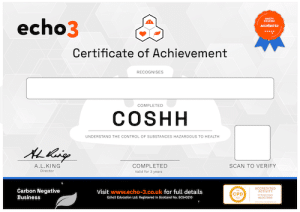
COSHH COURSE INCLUDES
WHAT IS A HAZARDOUS SUBSTANCE?
In COSHH regulations a hazardous substance is ‘any substance that may cause harm to your health‘. This is a broad definition, however, common examples include;
- chemicals
- products containing chemicals
- fumes
- dusts
- vapours
- mists
- nanotechnology
- gases and asphyxiating gases and
- biological agents (germs). If the packaging has any of the hazard symbols then it is classed as a hazardous substance.
- Germs
- Any substance with a WEL or Workplace Exposure Limit
Asbestos, lead and radioactive substances are all hazardous substances under COSHH. Because the hazards are so high they have their own specific regulations outlining what employers must do.
THE 9 HAZARD PICTOGRAMS
The 9 ‘hazards warning symbols’ or ‘hazard pictograms’ from the Global Harmonised System (GHS) are details below. These symbols are used on packaging across Europe to identify the hazard of a particular substance. Multiple hazard warning symbols are used when a substance has multiple hazardous properties.
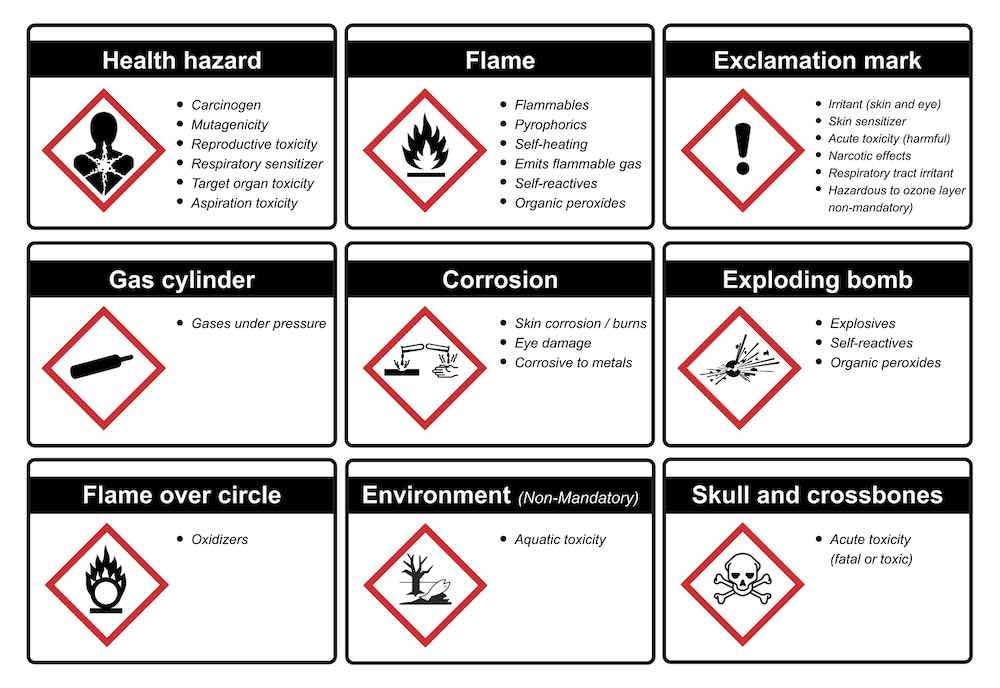
WHAT DOES COSHH REQUIRE
In short, COSHH regulations require that employers reduce the risk to staff from hazardous substances to as low as reasonably practicable.
In practice this means first undertaking a COSHH assessment. Walking round your business and noting which harmful substances are or could at time be present. Then consider what activities expose your staff to these substances and finally then what can be done to reduce the risk that someone might be harmed. All the steps you take should be documented.
One helpful step when substances cannot be eliminated from the workplace is to provide Hazardous Substances training to staff so they are aware of the risks and can therefore better avoid them.
WHAT TAKE THIS COSHH COURSE?
Every year, thousands of workers are made ill by hazardous substances, contracting lung disease such as asthma, cancer and skin disease such as dermatitis. You are probably aware of hazardous substances that are used in your workplace. Or are created as a consequence of work activities for example welding fumes or quarry dust.
Although the hazard from a substance is constant, the risk from that substance varies. For example, moving a flammable substances further away from an ignition source reduces the risk of explosion.
COSHH Regulations simply require employers to periodically assess the risks, and then adequately control them.
This online COSHH course helps to control risks by providing the knowledge needed to recognise hazards and respond appropriately.
ONLINE COSHH COURSE
 Online COSHH course (Control of Substances Hazardous to Health) equips participants with the knowledge needed to safely handle hazardous substances in the workplace.
Online COSHH course (Control of Substances Hazardous to Health) equips participants with the knowledge needed to safely handle hazardous substances in the workplace.
COSHH training is essential for protecting the health of staff and ensuring compliance with COSHH regulations.
LEARNING OBJECTIVES
On successful completion of the Echo3 COSHH course learners will;
- Understanding Hazardous Substances, gain an understanding of what hazardous substances are; including their various forms, classifications, and potential health risks.
- Know the COSHH Regulations; including the legal obligations of employers and employees.
- COSHH Risk Assessment, understand the role and importance of COSHH risk assessments and safety data sheets.
- Learn the Effective Control Measures, that mitigate risks associated with hazardous substances at work. For example, engineering controls, administrative controls, and personal protective equipment (PPE).
- How to Handling and Storage, hazardous substances safety.
- Know Emergency Responses to potentially use in case of spills, leaks, or exposure incidents.
WHO SHOULD TAKE THIS COURSE?
This online COSHH course is designed for everyone managing or supervising staff where hazardous substances are present.
Managers and supervisors responsible for overseeing workplaces where hazardous substances are used should be trained in COSHH. They are accountable for ensuring compliance with safety regulations and the protection of employees.
This course is applicable to all industries. However if you work in construction we offer a specific COSHH For Construction course with also covers concrete, asbestos and lead.
Staff should receive training about how to work hazardous substances. If you have particularly harmful substances present specific training on those substances should be provided by employers. We offer specific training on Asbestos, Nitrogen, H2S and Benzene.
Some jobs where COSHH applies;
- Cleaning: cleaning materials can cause localised burns and skin complaints
- Construction
- Bakeries: flour and bakery dust can cause irritation of eyes and nose, skin problems and asthma
- Garages: paints, solvents, oils and grease, and exposure to exhaust fumes can all damage their health
- Healthcare: exposure to biological agents can cause infection.
- Laboratories: exposed to chemicals, biological agents and flammable substances.
- Warehouses: Many handle a range of hazardous substances.
COURSE CONTENT
UNIT 1 | HAZARDOUS SUBSTANCES AND THE LAW
In this first unit we explain what hazardous substances are, the applicable legislation and its scope. We detail both employer and employee responsibilities. And outline how to classify, label and package hazardous substances as guided by the United Nations Globally Harmonised System (GHS).
UNIT 2 | HEALTH RISKS
In this second unit, we explore the health risks when working with and near hazardous substances, typical safe systems of work and practical action that can protect you and others.
UNIT 3 | WORKING SAFELY WITH HAZARDOUS SUBSTANCES
In this final unit, we look at risk assessments for working with hazardous substances, including how to store and dispose of them safely. Then we cover the hierarchy of control measures to follow and details each. We also look at how to respond to an accidental spill.
UNIT 4 | QUIZ
CERTIFICATE
Successful completion of the Echo3 COSHH course will result in certification, demonstrating participants’ knowledge of COSHH management and their ability to contribute to a safer and healthier work environment.
Our online COSHH course is accredited by the CPD Group, a recognised authority in accreditation. This accreditation ensures that our training program adheres to the highest standards.
You will be emailed your CPD-Accredited COSHH certificate once you have achieved 80% of more in the final assessment. A posted certificate is available for £9. The COSHH certificate is valid for 3 years.

COSHH COURSE INCLUDES
WHAT IS A HAZARDOUS SUBSTANCE?
In COSHH regulations a hazardous substance is ‘any substance that may cause harm to your health‘. This is a broad definition, however, common examples include;
- chemicals
- products containing chemicals
- fumes
- dusts
- vapours
- mists
- nanotechnology
- gases and asphyxiating gases and
- biological agents (germs). If the packaging has any of the hazard symbols then it is classed as a hazardous substance.
- Germs
- Any substance with a WEL or Workplace Exposure Limit
Asbestos, lead and radioactive substances are all hazardous substances under COSHH. Because the hazards are so high they have their own specific regulations outlining what employers must do.
THE 9 HAZARD PICTOGRAMS
The 9 ‘hazards warning symbols’ or ‘hazard pictograms’ from the Global Harmonised System (GHS) are details below. These symbols are used on packaging across Europe to identify the hazard of a particular substance. Multiple hazard warning symbols are used when a substance has multiple hazardous properties.

WHAT DOES COSHH REQUIRE
In short, COSHH regulations require that employers reduce the risk to staff from hazardous substances to as low as reasonably practicable.
In practice this means first undertaking a COSHH assessment. Walking round your business and noting which harmful substances are or could at time be present. Then consider what activities expose your staff to these substances and finally then what can be done to reduce the risk that someone might be harmed. All the steps you take should be documented.
One helpful step when substances cannot be eliminated from the workplace is to provide Hazardous Substances training to staff so they are aware of the risks and can therefore better avoid them.
WHAT TAKE THIS COSHH COURSE?
Every year, thousands of workers are made ill by hazardous substances, contracting lung disease such as asthma, cancer and skin disease such as dermatitis. You are probably aware of hazardous substances that are used in your workplace. Or are created as a consequence of work activities for example welding fumes or quarry dust.
Although the hazard from a substance is constant, the risk from that substance varies. For example, moving a flammable substances further away from an ignition source reduces the risk of explosion.
COSHH Regulations simply require employers to periodically assess the risks, and then adequately control them.
This online COSHH course helps to control risks by providing the knowledge needed to recognise hazards and respond appropriately.




